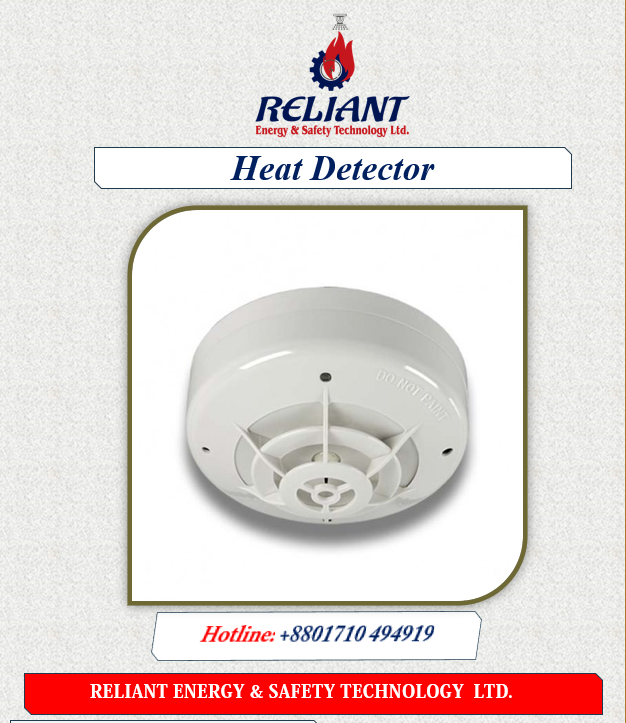There are always technological eyes watching over the world of fire safety, looking for signs of danger all the time. Most people are familiar with smoke detectors, but the heat monitor is also an important safety feature that often stands in the background. “How Does a Heat Detector Work?” is a question that gets to the heart of fire safety systems and shows us how important these quiet guardians are.
Understanding how heat monitors work is important for overall safety because they are an important part of any fire prevention plan. Heat detectors work in a different way than their more well-known counterparts, smoke alarms. We will talk about the different types, functions, and uses of heat detectors in this piece. This will help you understand how important they are for protecting people and property from fire damage.
What You Need to Know About Heat vs. Smoke Detectors
Before getting into the specifics of heat detectors, it’s important to know the difference between smoke detectors and heat detectors. They both play important roles in keeping people safe during fires.
Smoke Detectors: These devices work by picking up particles in the air that are released when things burn. When smoke particles get into the detector, they mess up a light beam or set off a photoelectric sensor, which sounds the alarm. Fire alarms that use smoke are very good at finding fires that are just starting or that are making a lot of smoke before they start to burn.
Heat Detectors: Heat detectors don’t react to smoke or combustion byproducts in the air like smoke alarms do. Instead, they keep an eye on how the temperature changes. The heat detector sounds a warning when the temperature inside the building reaches a certain level or rises quickly. Because of this, heat detectors can be used in places where smoke alarms might not work, like kitchens, garages, and places with a lot of dust or moisture.
Different Types of Heat Detectors
Different kinds of heat monitors are made to react to changes in temperature in different ways. Rate-of-rise heat detectors and fixed temperature heat monitors are the two main types.
1. Rate-of-Rise Heat Detectors: These devices are made to pick up on a temperature rise that happens quickly. They set off the warning when the temperature rises at a certain rate, usually above a certain level within a certain amount of time. This kind of heat monitor works best in places where fires can spread quickly, like where there are flammable materials or gases that can explode.
2. Fixed Temperature Heat Detectors: These turn on when the temperature around them hits a certain level. The detector sounds the warning when the temperature goes above the set point. Since they don’t depend on how fast the temperature rises, fixed temperature monitors can be used in places where slow, smoldering fires are more likely to happen.
3. Combination Detectors: Some heat detectors have both rate-of-rise and fixed temperature features, which makes them a complete answer for finding fires. This makes sure that they can find a wider range of fire situations, which makes them very flexible.
How Does a Heat Detector Work
At the heart of every heat detector is a sensor or element that can sense heat. This part is made to react to changes in temperature. The heat-sensitive element sets off an alarm or starts a fire suppression system when the temperature around it gets to a certain level.
The most important parts of a normal heat Detector are:
1. Heat-Sensitive Element: This is the heart of the heat detector. It is usually made from a material with known thermal properties. When exposed to heat, this element expands or undergoes a change in electrical resistance. This change is what triggers the alarm.
2. Circuitry: The heat-sensitive part is linked to electrical circuitry that detects changes in temperature and sends out the alarm signal.
3. Alarm or Notification Device: If the detector detects a large rise in temperature, it sets off a sound. This warning can be a loud noise, lights that flash, or a message sent to a fire alarm control panel.
Applications of Heat Detectors
Heat Detectors are useful in many places because they have special features that make them useful. The following are some popular uses:
1. Kitchens: Traditional smoke detectors can go off when there isn’t any smoke or steam in the room, so heat Detectors are often used there instead. Rate-of-rise heat detectors work really well in places where temperatures rise quickly, like around cooking fires.
2. Garages: There are often cars, tools, and materials in garages that can give off smoke or smells. In these places, heat detectors are better because they are less likely to set off false warnings.
3. Attics and basements: These places can get dusty or have humidity levels that change all the time, which makes them less ideal for smoke alarms. Fixed temperature heat Detectors are a good way to find fires in these places.
4. Industrial Facilities: Heat detectors help cut down on false warnings in warehouses and factories with high ceilings and heavy machinery. Because the amounts of dust and humidity in these places change all the time, heat detectors are a good choice.
Conclusion: The Vital Role of Heat Detectors in Fire Safety
An important part of making a complete fire safety plan is knowing how heat monitors work and where they should be used. As opposed to smoke detectors, heat detectors can reliably find fires in places where smoke detectors might not be useful because they respond to changes in temperature. They are very important for lowering the chance of false alarms and making buildings and facilities safer overall, which will save lives and property in the event of a fire.

